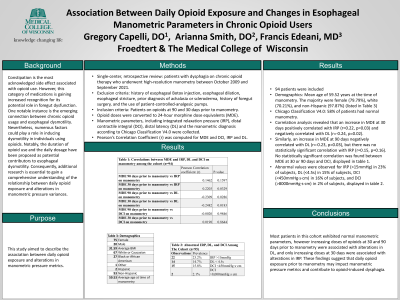Monday Poster Session
Category: Esophagus
P1840 - Association Between Daily Opioid Exposure and Changes in Esophageal Manometric Parameters in Chronic Opioid Users
Monday, October 23, 2023
10:30 AM - 4:15 PM PT
Location: Exhibit Hall

Has Audio

Arianna Smith, DO
Medical College of Wisconsin
Milwaukee, WI
Presenting Author(s)
Gregory Capelli, DO, Arianna Smith, DO
Medical College of Wisconsin, Milwaukee, WI
Introduction: Chronic opioid use has been linked to esophageal dysmotility, but further investigation is needed to understand the relationship between daily opioid exposure and changes in manometric pressure differences. This study aimed to describe the association between daily opioid exposure and alterations in manometric pressure metrics.
Methods: A retrospective review was conducted on patients with dysphagia on chronic opioid therapy who underwent high-resolution manometry between October 2009 and September 2021. Exclusion criteria included a history of esophageal Botox injection, esophageal dilation, esophageal stricture, prior diagnosis of achalasia or scleroderma, history of foregut surgery, and the use of patient-controlled-analgesic pumps. Patients on opioids at 90 and 30 days prior to manometry were included. Opioid doses were converted to 24-hour morphine dose equivalents (MDE). Manometric parameters, including integrated relaxation pressure (IRP), distal contractile integral (DCI), distal latency (DL) and the manometric diagnosis according to Chicago Classification V4.0 were collected. Pearson’s Correlation Coefficient (r) was computed for MDE and DCI, IRP and DL.
Results: Ninety-four patients were included, with a mean age of 59.52 years at the time of manometry. The majority were female (79.79%), white (70.21%), and non-Hispanic (97.87%). According to the Chicago Classification V4.0, 58% of patients had normal manometry. Abnormal values were observed for IRP ( >15mmHg) in 23% of subjects, DL (< 4.5s) in 15% of subjects, DCI (< 450mmHg·s·cm) in 16% of subjects, and DCI ( >8000mmHg·s·cm) in 2% of subjects. Correlation analysis revealed that an increase in MDE at 30 days positively correlated with IRP (r=0.22, p=0.03) and negatively correlated with DL (r=-0.24, p=0.02). Similarly, an increase in MDE at 90 days negatively correlated with DL (r=-0.23, p=0.03), but there was no statistically significant correlation with IRP (r=0.15, p=0.16). No statistically significant correlation was found between MDE at 30 or 90 days and DCI, displayed in figure 1.
Discussion: Most patients in this cohort exhibited normal manometric parameters, but increasing doses of opioids at 30 and 90 days prior to manometry were associated with alterations in DL, and only increasing doses at 30 days were associated with alterations in IRP. These findings suggest that daily opioid exposure prior to manometry may impact manometric pressure metrics and contribute to opioid-induced dysphagia.
Disclosures:
Gregory Capelli, DO, Arianna Smith, DO. P1840 - Association Between Daily Opioid Exposure and Changes in Esophageal Manometric Parameters in Chronic Opioid Users, ACG 2023 Annual Scientific Meeting Abstracts. Vancouver, BC, Canada: American College of Gastroenterology.
Medical College of Wisconsin, Milwaukee, WI
Introduction: Chronic opioid use has been linked to esophageal dysmotility, but further investigation is needed to understand the relationship between daily opioid exposure and changes in manometric pressure differences. This study aimed to describe the association between daily opioid exposure and alterations in manometric pressure metrics.
Methods: A retrospective review was conducted on patients with dysphagia on chronic opioid therapy who underwent high-resolution manometry between October 2009 and September 2021. Exclusion criteria included a history of esophageal Botox injection, esophageal dilation, esophageal stricture, prior diagnosis of achalasia or scleroderma, history of foregut surgery, and the use of patient-controlled-analgesic pumps. Patients on opioids at 90 and 30 days prior to manometry were included. Opioid doses were converted to 24-hour morphine dose equivalents (MDE). Manometric parameters, including integrated relaxation pressure (IRP), distal contractile integral (DCI), distal latency (DL) and the manometric diagnosis according to Chicago Classification V4.0 were collected. Pearson’s Correlation Coefficient (r) was computed for MDE and DCI, IRP and DL.
Results: Ninety-four patients were included, with a mean age of 59.52 years at the time of manometry. The majority were female (79.79%), white (70.21%), and non-Hispanic (97.87%). According to the Chicago Classification V4.0, 58% of patients had normal manometry. Abnormal values were observed for IRP ( >15mmHg) in 23% of subjects, DL (< 4.5s) in 15% of subjects, DCI (< 450mmHg·s·cm) in 16% of subjects, and DCI ( >8000mmHg·s·cm) in 2% of subjects. Correlation analysis revealed that an increase in MDE at 30 days positively correlated with IRP (r=0.22, p=0.03) and negatively correlated with DL (r=-0.24, p=0.02). Similarly, an increase in MDE at 90 days negatively correlated with DL (r=-0.23, p=0.03), but there was no statistically significant correlation with IRP (r=0.15, p=0.16). No statistically significant correlation was found between MDE at 30 or 90 days and DCI, displayed in figure 1.
Discussion: Most patients in this cohort exhibited normal manometric parameters, but increasing doses of opioids at 30 and 90 days prior to manometry were associated with alterations in DL, and only increasing doses at 30 days were associated with alterations in IRP. These findings suggest that daily opioid exposure prior to manometry may impact manometric pressure metrics and contribute to opioid-induced dysphagia.
Disclosures:
Gregory Capelli indicated no relevant financial relationships.
Arianna Smith indicated no relevant financial relationships.
Gregory Capelli, DO, Arianna Smith, DO. P1840 - Association Between Daily Opioid Exposure and Changes in Esophageal Manometric Parameters in Chronic Opioid Users, ACG 2023 Annual Scientific Meeting Abstracts. Vancouver, BC, Canada: American College of Gastroenterology.
